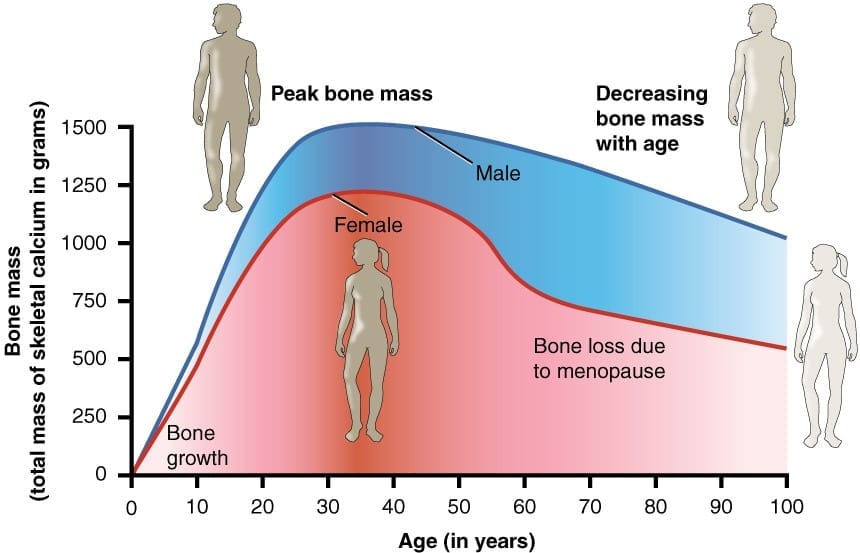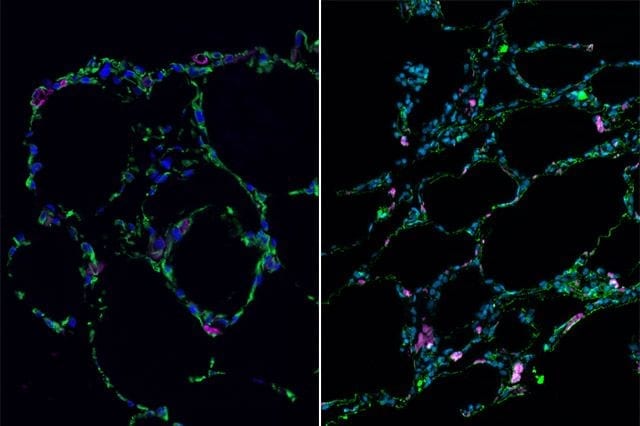
Imagine telling a patient suffering from age-related (type-II) osteoporosis that a single injection of stem cells could restore their normal bone structure. This week, with a publication in STEM CELLS Translational Medicine, a group of researchers from the University of Toronto and The Ottawa Hospital suggest that this scenario may not be too far away.
Osteoporosis affects over 200M people worldwide and, unlike post-menopausal (type-I) osteoporosis, both women and men are equally susceptible to developing the age-related (type-II) form of this chronic disease. With age-related osteoporosis, the inner structure of the bone diminishes, leaving the bone thinner, less dense, and losing its function. The disease is responsible for an estimated 8.9 M fractures per year worldwide. Fractures of the hip—one of the most common breaks for those suffering from type-II osteoporosis—lead to a significant lack of mobility and, for some, can be deadly.
But how can an injection of stem cells reverse the ravages of age in the bones?
Professor William Stanford, senior author of the study, had in previous research demonstrated a causal effect between mice that developed age-related osteoporosis and low or defective mesenchymal stem cells (MSCs) in these animals.
“We reasoned that if defective MSCs are responsible for osteoporosis, transplantation of healthy MSCs should be able to prevent or treat osteoporosis,” said Stanford, who is a Senior Scientist at The Ottawa Hospital and Professor at the University of Ottawa.
To test that theory, the researchers injected osteoporotic mice with MSCs from healthy mice. Stem cells are “progenitor” cells, capable of dividing and changing into all the different cell types in the body. Able to become bone cells, MSCs have a second unique feature, ideal for the development of human therapies: these stem cells can be transplanted from one person to another without the need for matching (needed for blood transfusions, for instance) and without being rejected.
After six months post-injection, a quarter of the life span of these animals, the osteoporotic bone had astonishingly given way to healthy, functional bone.
“We had hoped for a general increase in bone health,” said John E. Davies, Professor at the Faculty of Dentistry and the Institute of Biomaterials & Biomedical Engineering (IBBME) at the University of Toronto, and a co-author of the study. “But the huge surprise was to find that the exquisite inner “coral-like” architecture of the bone structure of the injected animals—which is severely compromised in osteoporosis—was restored to normal.”
The study could soon give rise to a whole new paradigm for treating or even indefinitely postponing the onset of osteoporosis. Currently there is only one commercially available therapy for type-II osteoporosis, a drug that maintains its effectiveness for just two years.
And, while there are no human stem cell trials looking at a systemic treatment for osteoporosis, the long-range results of the study point to the possibility that as little as one dose of stem cells might offer long-term relief.
“It’s very exciting,” said Dr. Jeff Kiernan, first author of the study. A graduate from IBBME who is beginning a Postdoctoral Fellowship at The Ottawa Hospital with the Centre for Transfusion Research, Kiernan pursued the research for his doctoral degree.
“We’re currently conducting ancillary trials with a research group in the U.S., where elderly patients have been injected with MSCs to study various outcomes. We’ll be able to look at those blood samples for biological markers of bone growth and bone reabsorption,” he added.
If improvements to bone health are observed in these ancillary trials, according to Stanford, larger dedicated trials could follow within the next 5 years.
Learn more: Stem cell therapy reverses age-related osteoporosis in mice
The Latest on: Age-related osteoporosis
[google_news title=”” keyword=”age-related osteoporosis” num_posts=”10″ blurb_length=”0″ show_thumb=”left”]
via Google News
The Latest on: Age-related osteoporosis
- New research investigates whether adequate sleep can help prevent osteoporosison May 7, 2024 at 10:40 pm
If a person is forming less bone while still resorbing the same amount -; or even more -; then, over time, that could lead to bone loss, osteoporosis, and increased fracture risk, Swanson said. "And ...
- Could getting enough sleep help prevent osteoporosis?on May 7, 2024 at 4:29 pm
In people's early- to mid-20s, they reach what is called peak bone mineral density, which is higher for men than it is for women, according to researchers. This peak is one of the main determinants of ...
- How Long to Take Alendronate for Osteoporosis?on May 6, 2024 at 4:59 pm
Alendronate has been shown to increase bone mineral density (BMD) and decrease fracture risk in postmenopausal women with osteoporosis ... women (mean age, 73) -- who had taken alendronate ...
- Osteoporosis and resistance trainingon May 5, 2024 at 5:06 pm
THE phrase “out of sight and out of mind” applies perfectly to our bones.“We rarely pay attention to our bones,”says family physician Dr Sasha Farrier who sees patients at the ...
- Osteoporosis Newson May 4, 2024 at 5:00 pm
Feb. 21, 2024 — With ever-increasing life expectancy comes the challenge of treating age-related disorders such as osteoporosis. Although there are effective drugs for treating this metabolic ...
- Over 50 and Can't Lose Weight? What to Know About Sarcopenia + How to Fix It With Proteinon May 3, 2024 at 4:12 am
Nothing I did felt hard!” Here, discover the toning moves, protein and sarcopenia tips you’ll want to know. Experts say muscle loss — scientific term: sarcopenia — impacts nearly every woman over 50.
- How to build strong bones as you ageon May 1, 2024 at 9:04 am
MPR News host Angela Davis talks with a sports medicine doctor and an endocrinologist about healthy bones. How can diet and exercise help prevent osteoporosis?
- Osteoarthritis, Osteoporosis and Osteopenia: What’s the Difference?on April 28, 2024 at 4:59 am
What's in a name? Well, if it's osteoporosis, osteopenia and osteoarthritis, for starters, a shared prefix. "Osteo" means bone, and that matching descriptor also spells confusion for many ...
- Drug-induced Osteoporosis in the Older Adulton April 17, 2024 at 5:00 pm
Prevention and treatment strategies for medication-related osteoporosis are largely extrapolated from the medical and pharmacotherapeutic principles of primary osteoporosis. Clinical trials data ...
- Pregnancy-associated osteoporosis (PAO) – what is it and what are the symptomson April 17, 2024 at 5:31 am
In comparison, other forms of osteoporosis are often related to factors such as ageing ... often resulting in osteoporosis at a relatively young age. In contrast, other types of osteoporosis ...
via Bing News










